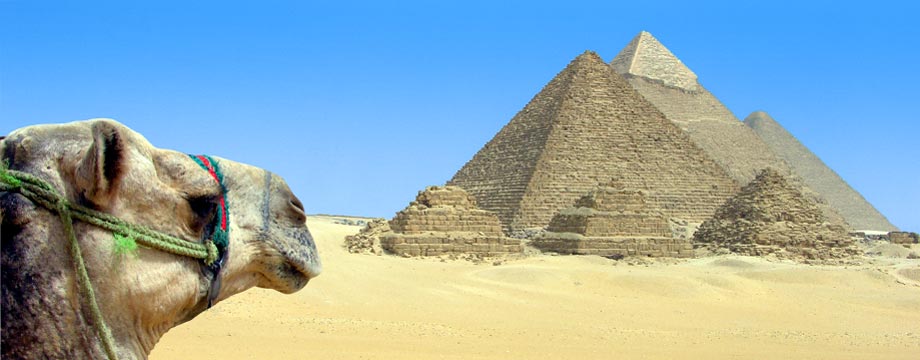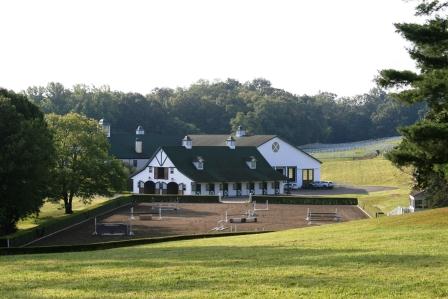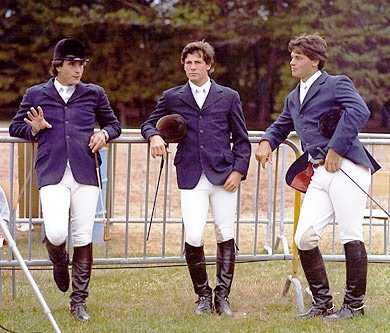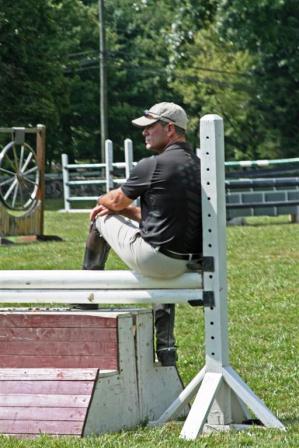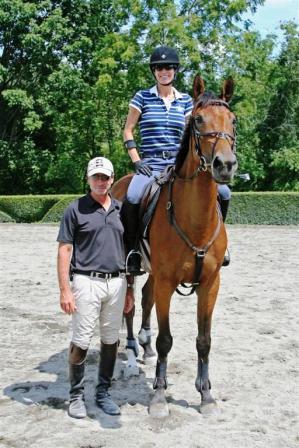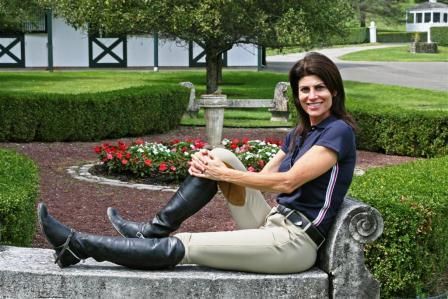After becoming a new columnist for Phelpssports.com I thought about who I would like my first professional rider interview to be with. It took about five seconds to decide upon Peter Leone. I had purchased his DVD, “Ride the Body,” this past winter at the urging of a friend. While he was clearly knowledgeable and successful in the sport, what I found even more compelling was how incredibly down to earth he seemed to be. So I reached out to Peter and asked him if he would consider being interviewed by me, but with a catch. I asked that he give me a lesson on my horse Jaliska as part of the deal. He graciously agreed and further suggested that I spend a few days shadowing him so I could learn firsthand what goes on behind the scenes at a real showjumping training facility. I jumped at the chance (no pun intended), and we locked down a date.
Although I must admit that Peter’s talents are somewhat wasted on me, being such a novice (don’t get me wrong – I learned a tremendous amount while I was there) for anyone wanting to up their game to the top level of the sport you should, without a doubt, make the trip to Lionshare Farm in Greenwich, Connecticut. The facilities alone are worth the trek (picture a gorgeous, grass Grand Prix ring overlooking the farms rolling hills of turnout), let alone to train with Peter himself and his awesome staff, is an experience not to miss. At the end of a very busy and exciting two days of training, watching and learning, I sat down with Peter to ask him a few questions. Now, I’m happy to share a transcript of our conversation with you.
Thank you so much for having me visit Lionshare Farm to experience your wonderful life here.
Welcome to my world. In small doses, it’s fantastic.
So tell me about your inspiration in getting involved in this sport. In reading your book (Peter Leone’s Show Jumping Clinic – Success Strategies for Equestrian Athletes) it seems that your mother was the equestrian in the family. Is she the one who got you into riding?
My mom always loved horses. She started me and my brothers riding at a very young age. I was around 5. She put us on ponies, and although I didn’t remember it, looking at some old pictures and videos, my mom actually used to teach us.
I read that your dad told you that you could achieve anything that you set your mind to.
When I was thirteen, my older brother was fifteen or sixteen (Armand) and younger brother (Mark) twelve, my dad and mom sat us down and said “look we are spending a lot of time and resources on these ponies and we are at the point where either we need to tailor it down and just have fun with it or we need to go full speed ahead and do it 150%. Now if you want to go for it, we should interview with George Morris, if not, we need to trim things back.” It wasn’t a very long meeting. Armand, Mark and I said, “We want to go for it!”
So your father connected you with George Morris. Was he as famous then, or more up and coming?George was the top junior equitation trainer in the country at the time. There were a few that tried to rival him, and came close, but he was the best.
I heard he is one tough cookie.
He can be. What George contributed to me and my brothers was a sense of discipline, detail, commitment and persistence. Those formative building blocks of being a complete rider, George gave to my brothers and me.
And obviously that shows in your tremendous capabilities.
You were so talented, handsome and successful (and your brothers the same). What was it like being Peter Leone, “Team Leone,” back then?
(Laughing) Life was good.
Were you a heartbreaker Peter?
It was not an accident that I was in a sport dominated by…
Gorgeous girls in tall boots?!
Young ladies.
That was actually a pretty strategic move on your part. You would think more boys would enter this sport because there are so many talented and athletic girls and not that many boys. Were you and your brothers onto something?
Show jumping has been very, very good to me! Just kidding…it was a lot of fun.
As you know, McLain Ward suffered a serious injury to his knee just prior to the Olympic trials this year. I’m sure this must have brought you back to when you were competing for a spot at the ‘96 games and you crushed your collarbone. Tell me, what is it with the top athletes in this sport to persevere and overcome that level of injury and pain to ultimately succeed and, in your case, win an Olympic medal?
Whatever the sport, a commitment to excellence and to winning is a core building block of a champion. I feel uncomfortable saying it, but I love to compete. I love to win. I love the pressure of having the game on the line, having done my homework and then going out there and engineering the performance that brings the win, or the medal. That’s what makes me tick.As far as injury goes, there’s no question that in any major contact sport, and the misconception may be that riding is not a contact sport, there is risk. It would be difficult for me to name a top, seasoned, international rider that hasn’t had a significant injury and overcome it. Maybe Chris Cappler, is the only rider who comes to mind who hasn’t had one.
OK, now you’re making me nervous. What can one do to be on the defensive against injury in this sport?
I am in the business, as a rider and a coach, of minimizing risk. When I teach a student, I introduce riding and jumping in such a way as to minimize the possibility of them getting hurt, or the horse stopping or being confused, which could result in an accident. There are many things we can do as riders to reduce risk, but mostly it is using common sense.
I think a lot has to do with taking really good care of your horse too, which you obviously do here, this place (Lionshare Farm) is like a spa for horses.
It’s like your car. If not properly taken care of it’s an accident waiting to happen. The prudent commuter makes sure that their vehicle is operating correctly. The same goes with your horse, although I am not likening the horse to a machine, but you want to make sure your horse is healthy, that they’re sound and fit so that when you ask them to answer an athletic question, like jumping a 1.4 meter fence, they can answer it safely.
I really enjoyed your book, especially being such a novice to showjumping, although anyone involved in this sport for any length of time can take away so much from your lifetime of experience detailed in it. How long was this work in progress for you?
I don’t know what it’s like to have a baby, but I guess it was a little bit like that. It took a while; it was two and a half years of writing and then printing took six months.
How did your book come to be?
My coauthor, Dr. Kimberly Jaussi, is a phenomenal talent. She understands horses and people and teaching. She came to my clinic and said after, “Peter this is really great stuff. Have you ever thought of writing a book?” I said, “yeah I would love to but I have never had the right person to do it with,” and she said, “I’ll do it with you, I’m the right person.” So I said, “let’s do it!” And I’m really proud of what we were able to do together.
Well you should be. I really loved it and it for sure it is helping me on my Quest for the Prix.
I’ve noticed that you have a propensity lately for Irish Sport Horses. My horse, Jaliska, is an Irish Sport horse. What do you like about them?
The Irish Sport Horse is a wonderful, wonderful horse. They tend to mature later, last longer and have a lot of heart… they’re the best.
For someone starting in the sport of show jumping so late in life, as in my case, and with such with a lofty goal to boot, what’s your advice to me, and to other novices out there?
There are two basic areas of advice that I can give you.
One – Work as much as you can with the best trainers that you can get access to – there is no substitute for top training. If it’s not financially viable, then get their books or take their clinics. Two– Repetition. Ride as much as you can. If you only have one horse, and that’s your situation, then every other day or so, ride them twice a day, for two shorter workouts, and that’s not for 52 weeks a year but for the times when you need more time in the saddle.
Excellent strategies for folks who are, shall we say, on a budget.
Another surprising benefit is watching, really studying top riders, not just what they are doing in the show ring but their morning workouts, their warm-ups prior to the competition…watch as much as you can. Lastly, be the driving force within yourself to climb that mountain.
That is really great advice. Thank you so much for having me and Jaliska out to Lionshare Farm. Do you think that can we come back some time?
I look forward to it and seeing you jump a meter twenty next time.
Photos by: TNT Photography
About Quest for the Prix
Victoria Waters’ column chronicles her trials and tribulations, the good the bad and the very ugly, in learning how to ride and compete at the top level of show jumping – a Grand Prix competition, as a middle-aged novice to the sport. Follow her Quest for the Prix at www.facebook.com/questfortheprix, www.questfortheprix.com or contact her at vwaters@questforthprix.com
About the Author
Victoria Waters, CEO of Green Education Foundation (GEF), a non-profit organization, is committed to creating a sustainable future through education. GEF provides free curriculum and resources to K-12 students and teachers worldwide with the goal of challenging them to think holistically and critically about global environmental concerns and solutions

